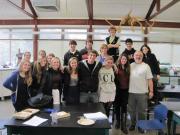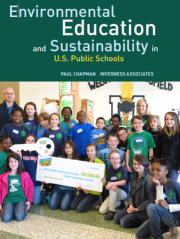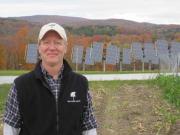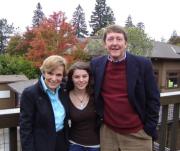Green Schools National Conference Report, Minneapolis, MN, October 24-25, 2010
“Growing Green Schools Across America”: Green Schools National Conference Report, Minneapolis, MN, October 24-25, 2010
The 1st Annual Green Schools National Conference attracted some 800 environmentalists from across the country in four different categories: formal school-based educators, environmental educators from the non-profit world, corporate representatives, and higher education. As a result of my attendance, I gained a better sense of the “big picture” in the emerging green school national movement; here are some of the leadership organizations I have identified:
•  AASHE--Association for the Advancement of Sustainability in Higher Education has developed STAR standards that the Group of 8 New England Boarding Schools is adapting for independent school use
AASHE--Association for the Advancement of Sustainability in Higher Education has developed STAR standards that the Group of 8 New England Boarding Schools is adapting for independent school use
• GSA: Green Schools Alliance—Founded in 2007 at a private-independent school in New York City, the GSA is an all volunteer network of almost 2000 schools promoting sustainability
• GCSN: Green Charter Schools Network—this group sponsored the national conference and is establishing a database of green school initiatives nationwide, including local networks, regional conferences, and national organizations
• NAAEE--North America Association for Environmental Education is promoting the development of Environmental Literacy Plans in connections with the No Child Left Inside legislation
• NAIS—Since 2003 the National Association for Independent Schools has promoted environmental sustainability through its website, conferences and support for 1400 members schools
• NEEEA--New England Environmental Education Alliance has been orchestrating the work of six New England states for over forty years
• NWF: Eco-Schools—Founded in 1994 to green schools worldwide and now engaged in 47 countries and 30,000 schools, Eco-Schools-USA has been hosted in America by the National Wildlife Federation since 2008
Jim McGrath, Executive Director of the Green Charter Schools Network, convened a gathering of about 75 participants for a workshop to start the conference. 
Several leaders gave short presentations:
• Rachel Gutter, from The Center for Green Schools of the US Green Building Council, described the LEED for Green Schools Rating System, said we need three kinds of people: to make the case for green schools, to make decisions about green schools, and to take action to make it happen. There are 1000 green schools committee members at the grassroots level. The USGBC is preparing a toolkit to help educators explain why green cuts costs and improves student performance.
• Bill Orr from CHPS (Coalition of High Performing Schools) noted that there are 133,000 schools nationwide, that we are only building about 100 per year and that greening schools must focus on renovating existing structures. If we are to revamp the nation’s schools in a generation, or approximately 25 years, we will have to overhaul 5000 schools a years, or 15 a day!
• David Sobel, author of Place Based Education, urged that we develop a better model of school improvement and that we “walk softly and carry a green stick” by focusing on achievement measures and the way green schools can help close the gap.
• Victoria Ryberg, from the Wisconsin Department of Public Instruction, argued for a broad definition of environmental education and that we use environmental education to raise achievement.
Subsequently I met with two green schools leaders
• Wynn Calder, from Sustainable Schools, has been the key consultant to NAIS on supporting and improving the organization’s efforts and has played a vital role in the emergence of the Green Schools Alliance.
• Brian Day, Executive Director of the North American Association for Environmental Education in Washington, DC, described NAAEE’s 70+ years of work, his engagement as a high school student during Earth Day, and the programs of the organization.
I attended a number of keynote sessions in my time at the conference:
• David Sobel, “Place-Based Education: Test Scores and Going Beyond Test Scores.” The guru of place-baced education, David Sobel is the director of teacher certification in the Department of Education and director of the Center for Place-Based Education at Antioch University New England. Previously he directed CO-SEED, Community-based School Environmental Education. He gave a very literate and compelling presentation of why education that is focused on the local community and environment is so engaging for students and teachers and makes such a demonstrable impact on their learning. Recalling a moment when the California-based Moore Foundation rejected a grant proposal because they concluded it would not be possible to demonstrate impact, Sobel proceeded to explain the recent research on how PBE improves academic achievement, environmental stewardship, and environmental quality. Citing numerous examples from schools across the country, he argued that the environmental literacy movement cannot rely on moral suasion but must provide concrete research based on data that demonstrates student success. His concluding video on the resurrection of the Guilford VT general store showed how PBE can inspire students and transform a community.
• Michael Stone, “Smart By Nature.” Michael Stone from the Center for Ecoliteracy in Berkeley CA did an excellent job of presenting an overview of the work of CEL and the theory behind schooling for sustainability. Providing examples of recent publications (Food, Inc. and Nourish), he then proceeded to describe four ways CEL helps schools to: overcome isolation and build networks; work with a wide variety of institutions; address challenges ($, bureaucracy, APs, state testing); and manage the change process. Offering a definition of sustainability and describing Fritjof Capra’s work, he outlined the principles of ecology (balance, cycles, flow, diversity, networks), described the way schools function as an ecosystem, and discussed the curriculum reform process. Outlining the four themes in the recent book Smart By Nature, he gave numerous examples of schools addressing--food, campus, community, and teaching and learning. Similarly, his overview of the “guiding principles” included examples of schools where nature is our teacher, sustainability is a way of life, the real world is the optimal learning environment, and sustainability is rooted in deep knowledge of place. The concluding story of STRAW (Students and Teachers Restoring a Watershed) in Marin County pulled all the themes together.
• Ann Cooper, “School Food Reform: Solutions to the School Food Crisis.” The former director of the Berkeley Schools Sustainable Food Program, Ann Cooper is now head of Lunch Lessons in Boulder, Colorado, where she has formed the Food Family Farming Foundation. Her message that we have a “crazy” national food policy and practice was delivered with force and passion. She described her School Food Project initiative, and announced the Salad Bar Project.org that will give to schools a free salad bar. Her detailed demonstration of the Lunchbox.org web site revealed that this is a powerful resource for school lunch programs that provides information on the following: menu planning, technical details, training videos, financial modeling tools, calendar templates, lunch waste, feasibility studies, assessment tools, evaluation of school lunch initiatives.
Based on the success of this first annual conference, GSNC is well poised to help orchestrate the growing national green schools movement.











